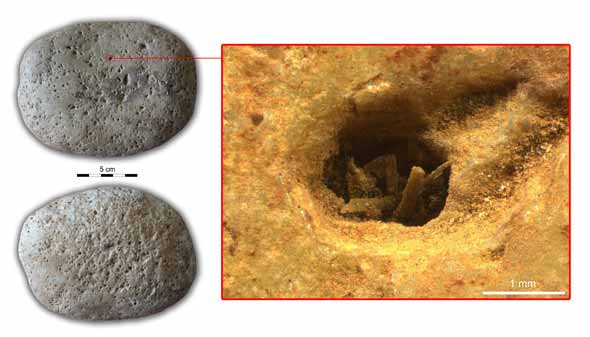 |
| 3/6. Upper grinder found in the Neolithic layers of the cave, with plant residues stuck inside a crevice (Giulio Lucarini) |
Analysis of grinding stones reveals that North African communities may have moved slowly and cautiously from hunter-gatherer lifestyles to more settled farming practices. Newly published research by Cambridge archaeologist Dr Giulio Lucarini suggests that a preference for wild crops was a strategic decision.
A box of seemingly unremarkable stones sits in the corner of Dr Giulio Lucarini’s office at the McDonald Institute for Archaeological Research where it competes for space with piles of academic journals, microscopes and cartons of equipment used for excavations. These palm-sized pebbles were used as grinding tools by people living in North Africa around 7,000 years ago. Tiny specks of plant matter recently found on their surfaces shine light on a fascinating period of human development and confirm theories that the transition between nomadic and settled lifestyles was gradual.
The artefacts in Lucarini’s office come from a collection held in the store of the Museum of Archaeology and Anthropology (MAA) just a couple of minutes’ walk away. In the 1950s the well-known Cambridge archaeologist Sir Charles McBurney undertook an excavation of a cave called Haua Fteah located in northern Libya [...] University of Cambridge
Link 2: Resistencia a las nuevas prácticas agrícolas por parte de poblaciones neolíticas en Libia
Análisis en piedras de moler revela que las comunidades del norte de África pudieron haberse pasado lentamente de los estilos de vida de cazadores-recolectores a las prácticas agrícolas más generalizadas. La investigación recién publicada por el arqueólogo Dr. Giulio Lucarini de la Universidad de Cambridge, sugiere que hubo una decisión estratégica en preferencia de estas poblaciones por los cultivos silvestres...
More information: Giulio Lucarini et al. The exploitation of wild plants in Neolithic North Africa. Use-wear and residue analysis on non-knapped stone tools from the Haua Fteah cave, Cyrenaica, Libya, Quaternary International (2016). DOI: 10.1016/j.quaint.2015.11.109







No hay comentarios:
Publicar un comentario